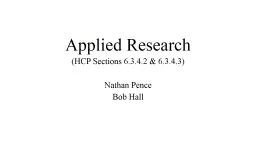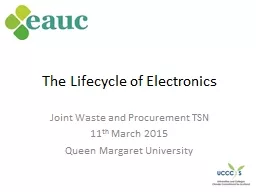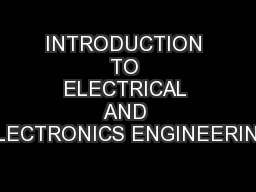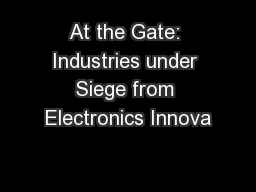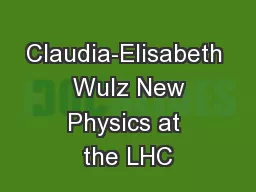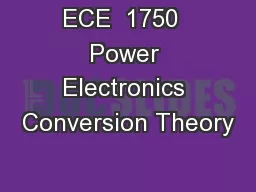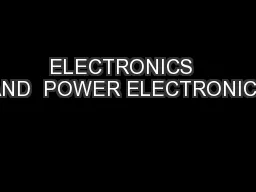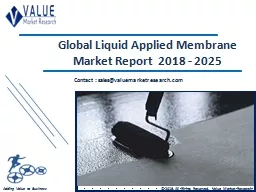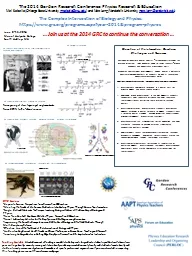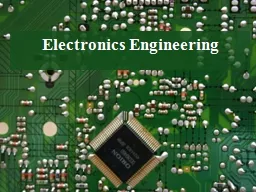PPT-1 Institute for Research in Electronics & Applied Physics
Author : backbays | Published Date : 2020-09-22
University of Maryland College Park MD USA The Nonlinear Structure of Multipactor Rami A Kishek Research sponsored by National Science Foundation Earlier work
Presentation Embed Code
Download Presentation
Download Presentation The PPT/PDF document "1 Institute for Research in Electronics ..." is the property of its rightful owner. Permission is granted to download and print the materials on this website for personal, non-commercial use only, and to display it on your personal computer provided you do not modify the materials and that you retain all copyright notices contained in the materials. By downloading content from our website, you accept the terms of this agreement.
1 Institute for Research in Electronics & Applied Physics: Transcript
University of Maryland College Park MD USA The Nonlinear Structure of Multipactor Rami A Kishek Research sponsored by National Science Foundation Earlier work by US DOE and U Maryland Division of Research. Focus on Learning, . Part 2. Mark Hoddenbagh. 2012 June 05. St. Lawrence College. Through . active participation in the Focus on Learning Program, participants will have demonstrated their ability . to f. (. HCP Sections . 6.3.4.2 & 6.3.4.3. ). Nathan Pence. Bob Hall. . Categories. Tier A. primarily focus on habitat requirements and responses.. Tier B. primarily focus on low-flow impacts directly on the fountain darter and Comal Springs riffle beetle.. Joint Waste and Procurement TSN. 11. th. March 2015. Queen Margaret University. Agenda. 10-00 Registration and refreshments. 10-15 Welcome and Introductions. 10-30 Electronics and the Circular Economy in HFE. Sakarya Üniversitesi. Teknoloji Fakültesi. Elektrik Elektronik Mühendisliği Bölümü . T4 Blok. Introducing. . the. . department. . Introducing. . the. EEE. Engineering. . ethic. . Unit. . Jonathan Melnick, Ph.D.. Senior Analyst. Jonathan.melnick@luxresearchinc.com. . Agenda. Historic disruption in electronics. New disruption in electronics is cross-industry. Disruption is a two-way street. Eric Burger and Dolores Zage. Applied Research. Welcome to the real world. Applied and Traditional Research. Applied research is an uneasy topic in academia. How is applied research different than consulting?. C.-E. . Wulz. (Institute of High Energy Physics). 1. Institute of High Energy Physics of the Austrian Academy of Sciences . New Physics at the LHC. Experimental environment. 2. Week 0. ECE 1750 - Power Electronics Conversion Theory. Tuesdays and Thursdays from 2:30 pm to 3:45 pm. Professor: Alexis . Kwasinski. (. Benedum. Hall 1229, akwasins@pitt.edu, Ph: 412-383-6744).. Nisha Kondrath. Assistant Professor. Dept. of Electrical and Computer Engineering. University of Minnesota Duluth. Background. Education. Doctor of Philosophy in Engineering. Wright State University, Dayton, OH, 2010. January. 6-9. 2014. Las Vegas, USA. Overview. 2.2 million net square feet of exhibit space featuring more than 3,600 exhibitors. conference program with 250 sessions; and 150,000 to 160,000 attendees from more than 140 countries.. XYZ Market report published by Value Market Research is an in-depth analysis of the market covering its size, share, value, growth and current trends for the period of 2018-2025 based on the historical data. This research report delivers recent developments of major manufacturers with their respective market share. In addition, it also delivers detailed analysis of regional and country market. View More @ https://www.valuemarketresearch.com/report/liquid-applied-membrane-market Mel Sabella (Chicago State University, . msabella@csu.edu. ) and Matt . Lang (Vanderbilt University, . matt.lang@vanderbilt.edu. ). The Complex Intersection of Biology and . Electronics Engineering What's electronics? Electron is just a particle that can't be defined, but it has charge & tendency to flow. This nature of electron has made a separate section of study called electronics engineering . By. Baktash. . Amini. On behalf of. Physics Faculty, Kabul University . 20-21 June . 2017. Background of Physics in Afghanistan academia. Physics department: . was established in 1942 at science faculty of Kabul University. .
Download Document
Here is the link to download the presentation.
"1 Institute for Research in Electronics & Applied Physics"The content belongs to its owner. You may download and print it for personal use, without modification, and keep all copyright notices. By downloading, you agree to these terms.
Related Documents


